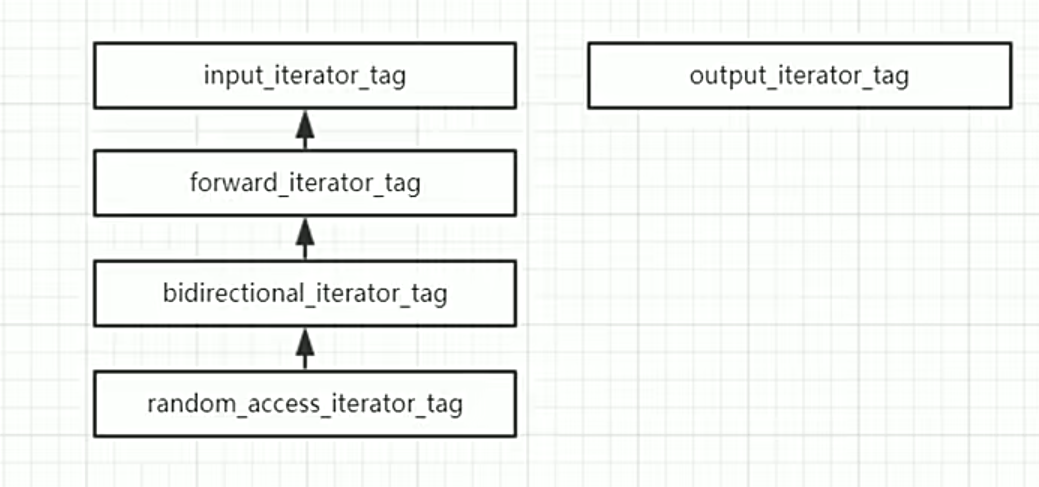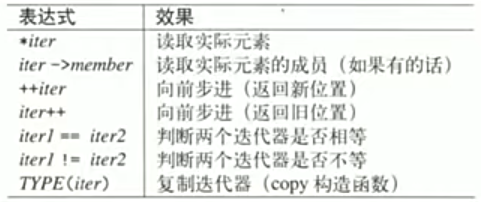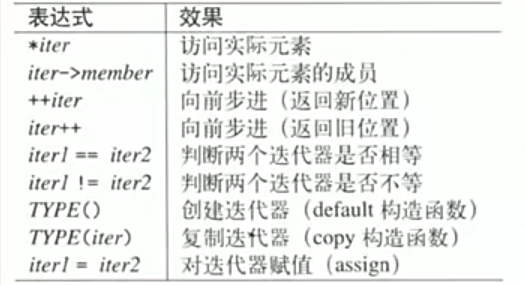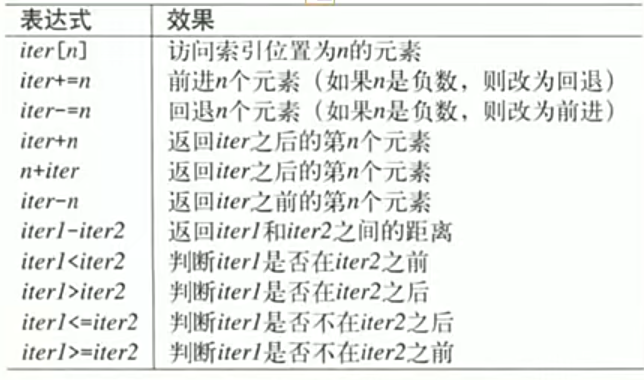迭代器简介
迭代器是种遍历容器内元素的 数据类型,这种数据类 型感觉有点像指针,我们理解的时候就理解为迭代器用来指向容器中的某个元素。
string, vector, [], 很少用[]来访问元素,更常用的访问方式就是用迭代器(更通用)。
通过迭代器,我们就可以读容器中的元素值,读string中的每个字符,还可以修改某个迭代器所指向的元素值。迭代器像指针一样支持++,–操作
list,map,通常用迭代器来访问元素。
容器的迭代器类型
1
2
| vector<int> iv = {100,200,300};
vector<int>::iterator iter;
|
每个容器都会定义一个iterator固定成员,可以把整个vector<int>::iterator理解为一个类型,这种类型就专门应用于迭代器。
当我们用这个类型定义一个变量的时候,这个变量,就是个迭代器,这里iter这个变量就是个迭代器。
迭代器操作
迭代器begin()/end()操作
begin()/end()返回的是迭代器类型,可以理解为返回一个迭代器。
1
2
3
4
5
6
| vector<int> iv = {100,200,300};
vector<int>::iterator iter;
iter = iv.begin();
iter = iv.end();
|

如果一个容器是空容器,那么begin()和end()返回的迭代器相同。
1
2
3
4
5
| vector<int>iv2;
vector<int>::iterator iterbegin = iv2.begin();
vector<int>::iterator iterend = iv2.end();
if (iterbegin == iterend)
cout<< "容器iv2为空" << endl;
|
传统用法:
1
2
3
4
| vector<int> iv = {100,200,300};
for(vector<int>::iterator iter = iv.begin();iter != iv.end();iter++){
}
|
反向迭代器rbegin()/rend()操作

反向迭代器:大家想从后往前遍历一个容器,那么反向迭代器就比较方便。
反向迭代器(逆向迭代器),用的rbegin(), rend() ;
rbegin():返回一个反向迭代器,指向反向迭代器的第一个元素;
rend():返回一个反向迭代器,
迭代器运算符
*iter
*iter:返回迭代器iter所指向元素的引用。**必须要保证这个迭代器指向的是有效的容器元素,不能指向end(),**因为end()是末端元素的后边。也就是end指向的是一个不存在的元素。
++iter,–iter
++让迭代器指向容器的下一个元素,已经指向end()的时候你不能再++iter;
--让迭代器指向容器的上一个元素,已经指向begin()的时候不能再--iter;
==,!=
iter1 ==iter2, iter1!= iter2。判断两个迭代器是否相等。
如果两个迭代器指向的是同一个元素,就相等,否则就不等。
如何引用结构的成员
1
2
3
4
5
6
7
8
9
10
11
12
13
14
15
16
17
18
19
| struct student{
int num;
};
int main(){
vector<student> sv;
student mystu;
mystu.num = 100;
sv.push_back(mystu);
vector<student>::iterator iter;
iter = sv.begin();
cout << (*iter).num << endl;
cout << iter->num << endl;
return 0;
}
|
const_iterator迭代器
表示迭代器指向的元素的值不能改变,但迭代器本身可以改变,可以不断指向下一个元素。表示只能读元素,不能通过这个迭代器改写元素,有点像常量指针。实际而言还是可以修改元素的,只是不用能代器修改元素。
1
2
3
4
5
6
7
8
9
10
11
12
13
14
15
16
| #include<iostream>
#include<vector>
using namespace std;
int main() {
vector<int> iv = { 100,200,300 };
vector<int>::const_iterator iter;
iv[1] = 2000;
for (iter = iv.begin(); iter != iv.end(); iter++) {
cout << *iter << " ";
}
return 0;
}
|
cbegin(),cend()
c++11引入的两个新函数cbegin (), cend(),跟begin, end类似。cbegin,cend,返回的都是常量迭代器
迭代器失效
1
2
3
4
5
6
7
8
| for (auto e : iv) {
cout << e << endl;
}
for (auto beg = iv.begin(),end = iv.end(); beg != end; ++beg){
cout << *beg << endl;
}
|
在操作迭代器的过程中(使用了迭代器这种循环体),千万不要改变vector容器的容量,不要增加或者删除vector容器中的元素
往容器中增加或者从容器中删除元素,这些操作可能会使指向容器元素的指针、引用、迭代器失效,
失效就表示不能再代表任何容器中的元素。一旦使用失效的东西,就等于犯了严重的错误,程序会直接崩溃。
iv.insert(begin,800)插入新值,第一个参数为插入位置,第二个参数为插入的元素。
这一插入,肯定会导致迭代器失效。比如begin, end失效。
具体的哪个迭代器失效,取决于这个容器vector内部的实现原理,最明智的做法,就是我们只要一插入数据, 插入完毕就break出循环体
1
2
3
4
5
6
7
8
9
10
11
12
13
14
15
16
17
18
19
20
21
22
23
24
25
26
27
28
| #include<iostream>
#include<vector>
using namespace std;
int main() {
vector<int> iv = { 100,200,300,400,500 };
vector<int>::iterator iter;
auto end = iv.end();
while (iter != iv.end()) {
iv.erase(iter);
}
while (iter != iv.end()) {
iter = iv.erase(iter);
}
iv.clear();
while (!iv.empty()) {
auto iter = iv.begin();
iv.erase(iter);
}
return 0;
}
|
迭代器分类

大多数容器里边都有一个::iterator迭代器类型;并不是所有容器里都有迭代器;比如stack,queue这种容器就不提供迭代器;
1
2
3
4
5
6
7
8
9
10
11
12
13
14
15
16
17
18
19
20
21
22
23
24
25
26
27
28
29
30
31
32
33
34
35
36
37
38
39
40
41
42
43
44
45
46
47
48
49
50
51
| #include <iostream>
#include <vector>
#include <array>
#include <list>
#include <map>
#include <set>
using namespace std;
void _display_category(input_iterator_tag) {
cout << "input_iterator_tag" << endl;
}
void _display_category(random_access_iterator_tag) {
cout << "random_access_iterator_tag" << endl;
}
void _display_category(forward_iterator_tag) {
cout << "forward_iterator_tag" << endl;
}
void _display_category(output_iterator_tag) {
cout << "output_iterator_tag" << endl;
}
void _display_category(bidirectional_iterator_tag) {
cout << "bidirectional_iterator_tag" << endl;
}
template <typename T>
void display_category(T ite) {
cout << "-------------begin-------------" << endl;
typename iterator_traits<T>::iterator_category cagy;
_display_category(cagy);
cout << "typeid(ite).name = " << typeid(ite).name() << endl;
cout << "-------------end-------------" << endl;
}
void func()
{
display_category(array<int, 100>::iterator());
display_category(vector<int>::iterator());
display_category(list<int>::iterator());
display_category(map<int, int>::iterator());
display_category(set<int>::iterator());
}
int main()
{
func();
return 0;
}
|
1
2
3
4
5
6
7
8
9
10
11
12
13
14
15
16
17
18
19
20
| -------------begin-------------
random_access_iterator_tag
typeid(ite).name = class std::_Array_iterator<int,100>
-------------end-------------
-------------begin-------------
random_access_iterator_tag
typeid(ite).name = class std::_Vector_iterator<class std::_Vector_val<struct std::_Simple_types<int> > >
-------------end-------------
-------------begin-------------
bidirectional_iterator_tag
typeid(ite).name = class std::_List_iterator<class std::_List_val<struct std::_List_simple_types<int> > >
-------------end-------------
-------------begin-------------
bidirectional_iterator_tag
typeid(ite).name = class std::_Tree_iterator<class std::_Tree_val<struct std::_Tree_simple_types<struct std::pair<int const ,int> > > >
-------------end-------------
-------------begin-------------
bidirectional_iterator_tag
typeid(ite).name = class std::_Tree_const_iterator<class std::_Tree_val<struct std::_Tree_simple_types<int> > >
-------------end-------------
|


输入迭代器用于从一个对象中不断读出元素。
除了迭代器基本操作,还需要支持:
- 比较两个迭代器是否指向相同元素
i == j 和 i != j
- 访问元素的成员
i->m
- 后缀自增操作
i++
输入迭代器不需要保证自增操作之后,之前的迭代器依然有意义。典型的例子是用于读取流文件的迭代器:每次自增之后,都无法回复到原来的位置。也包括随机数生成器的迭代器:每次自增之后,随机数生成器的状态都发生了变化。
输出迭代器 (output iterator)

输出迭代器用于向一个对象不断添加元素。
除了迭代器基本操作,还需要支持:
- 修改元素
*i = v
- 后缀自增操作
i++
输出迭代器也不保证自增之后,之前的迭代器有意义,并且它还不保证修改元素之后访问元素有意义。典型的例子是用于写入流文件的迭代器和向容器中插入元素的 **插入迭代器 (insert iterator)**。
前向迭代器 (forward iterator)

前向迭代器用于访问一个容器中的元素。
因此,它必须提供输入迭代器的所有操作,如果它用于访问一个非 const 容器,还需要支持输出迭代器的所有操作。
在此基础上,它需要保证自增之后,其他的迭代器仍然有意义(比输入迭代器要求更高)。它也需要保证可以不受限制地修改和访问当前元素(比输出迭代器要求更高)。
典型的例子包括各种容器的迭代器,比如 vector、list、map 的迭代器。
双向迭代器 (bidirectional iterator)

双向迭代器首先是一个前向迭代器,除此之外,它还需要支持自减操作 --i 和 i-- 。
一个线性存储元素的容器应该提供双向迭代器,例如 vector 和 list。
随机访问迭代器 (random access iterator)

随机访问迭代器是所有迭代器种类中最强大的,它除了需要支持前向迭代器的所有操作,还支持加上任意偏移量并得到新的迭代器,即 i + n,其中 n 可以是正数也可以是负数,分别表示向前或向后随机访问。
它需要支持的完整操作包括:
- 加上或减去一个偏移量
i + n 和 i - n
- 自加或自减一个偏移量
i += n 和 i -= n
- 计算两个迭代器的距离
i - j
- 使用下标形式的加上一个偏移量
i[n],其效果等价于 *(i + n)
- 比较两个迭代器的先后顺序
a < b a <= b a > b a >= b
我们可以发现,随机访问迭代器在功能上已经等价于指针。
一般来说,只有 vector 这类线性且连续存储元素的容器才会提供随机访问迭代器。











